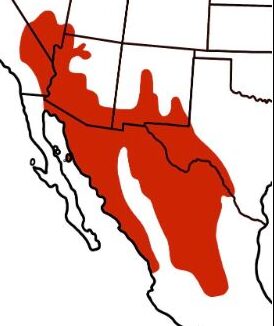Cactus Mouse, Peromyscus eremicus
 Cactus Mouse, Peromyscus eremicus. Photograph taken within the greater Palm Springs area of southern California, March 2021. Photograph courtesy of Dr. Tom Bartol, Carlsbad, California.
Cactus Mouse, Peromyscus eremicus. Photograph taken within the greater Palm Springs area of southern California, March 2021. Photograph courtesy of Dr. Tom Bartol, Carlsbad, California.
The Cactus Mouse, Peromyscus eremicus, is a member of the Cricetidae family of True Hamsters, Lemmings, Mice, Muskrats, New World Rats and Voles. The Cricetidae Family consists of seven hundred six members placed into one hundred forty-one genera. There are fifty-seven members in the Peromyscus genus. The Mesquite Mouse, Peromyscus merriami, and Eva’s Desert Mouse, Peromyscus eva, were formerly considered as the Cactus Mouse. Populations found in southwestern California and northern Baja California are now recognized as a distinct species, the Northern Baja Deer Mouse, Peromyscus fraterculus. The Cactus Mouse is known in Mexico as Ratón de Cactus.
Cactus Mice have a thick, long, and silky pelage that varies in color depending upon their environment. In general, they are a dusky brownish-yellow color dorsally with a white lateral line that extends along their sides and onto the outer surfaces of their front legs. Their ventral pelage is white. Their tail is nearly naked, flesh-colored, and is equal to or longer than the length of their head and body. They have naked soles on their hind feet. Their ears are relatively large, sparsely haired, and membranous. Unlike other mice species, they lack internal cheek pouches. Slight sexual dimorphism is displayed with females growing larger and weighing more than the males. They reach a total body length between 8.0 cm (3.2 inches) and 9.0 cm (3.5 inches), not including their 10.0 cm (3.9 inch) to 14.0 cm (5.5 inch) long tail. Their weight varies between 18 g (0.6 ounces) to 40 g (1.4 ounces) , with an average of 20 g (0.7 ounces).
Cactus Mice are excitable and shy, only emerging at night. They display two main adaptations for their desert habitat; a lowered metabolism and the ability to enter a state of torpor during the day and periods of unfavorable temperatures. Cactus Mice have been described as quiet and docile in captivity, and seldom bite when handled. They display a loose social structure with a promiscuous mating system. Cactus Mice remain reproductively active throughout the year, with activity peaking in March through April. During the hot periods of summer, reproduction is halted. They build nests in self-dug tunnels, homes of other rodents, brickwork buildings, and piles of rock or brushwood. Gestation lasts for approximately twenty to twenty-five days. Litter sizes range from one to four offspring, and some females may have up to four litters per year. Female Cactus Mice have two pairs of teats to nurse their young rather than three, likely correlating with their litter size. The young are altricial, being born with their eyes and ears closed, and weigh an average of 2.5 g at birth. Neonates are naked and pink, except for a pigmented dorsum, and usually have complete gray juvenile pelage after fourteen days. Their eyes open ten to fifteen days after birth. Females reach sexual maturity at two months of age. The Cactus Mouse has lifespan of one year in the wild and more than seven years in captivity.
Cactus Mice communicate with vocalizations that have been described as thin squeaks and shrill buzzings. When excited, they thump their forefeet rapidly upon the ground to produce a drumming noise. Like other Peromyscus species, Cactus Mice have keen vision and hearing and use chemical cues in communication. Cactus Mice are opportunistic omnivores and their diet consists of various fruits, flowers, seeds, insects, and green vegetation. These are consumed in varying amounts depending upon seasonal abundance. They are preyed upon by Foxes, Owls, Rattlesnakes, and other larger predators. Additionally, they are parasitized by a variety of Bot Flies, Chiggers, Fleas, Lice, Mites, Nematodes, and Ticks.

From a conservation perspective, the Cactus Mouse is currently considered to be of Least Concern due to their wide distribution and presumed large population size. No major threats have been identified for this species.